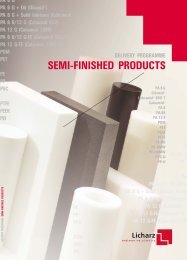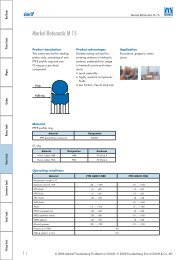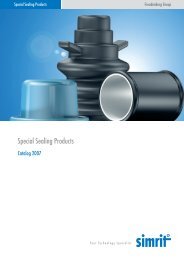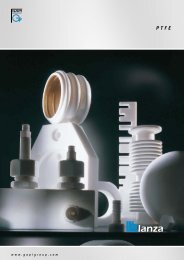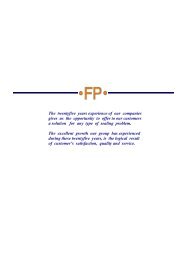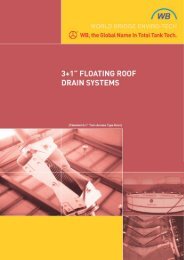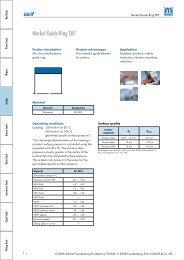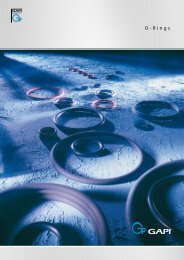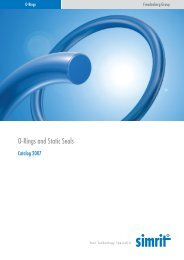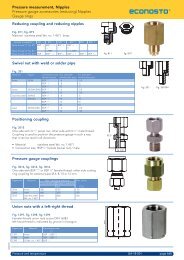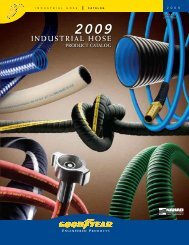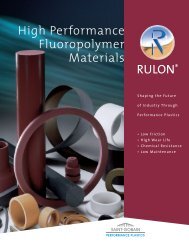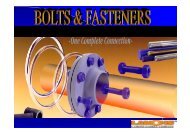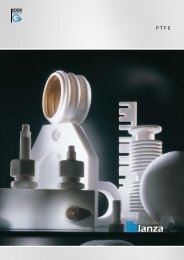Oleodinamica/Pneumatica Hydraulic/ Pneumatic
Oleodinamica/Pneumatica Hydraulic/ Pneumatic
Oleodinamica/Pneumatica Hydraulic/ Pneumatic
You also want an ePaper? Increase the reach of your titles
YUMPU automatically turns print PDFs into web optimized ePapers that Google loves.
HIS<br />
AnELLI GuIDA InTERnO TIPO HIS<br />
Descrizione<br />
I pattini di guida tipo HIS, hanno la funzione di<br />
mantenere in asse tutto il sistema cilindro (stelo con<br />
testata, pistone con camicia). Svolgono una funzione<br />
importante aiutando la tenuta stelo, il raschiatore e<br />
la tenuta pistone a lavorare senza disallineàmenti<br />
garantendo nello stesso momento il non contatto<br />
delle parti metalliche tra loro. Il materiale con un<br />
coefficiente di attrito molto basso non crea perdite<br />
di carico (linearità). Sopporta deformazioni sotto<br />
carico elevate avendo un punto di rammollimento<br />
vicino al punto di fusione (lavora in esercizio a 115°<br />
C). Per facilitare la scelta della guida pistone o stelo<br />
consigliamo questa formula per conoscere l’altezza<br />
della guida da inserire nel sistema.<br />
h=Fx2 per pistone e h=Fx2 per stelo<br />
DxQ dxQ<br />
Dove:<br />
h = altezza guida in mm.<br />
F = forza radiale applicata<br />
Q = forza radiale sopportata dal materiale<br />
D = diametro camicia<br />
d = diametro stelo<br />
Dati tecnici<br />
Velocità: < 0,8 m/s<br />
Temperatura: da - 40° C a + 115° C<br />
Carico radiale Q: 35 N/mm2 a temperatura di 60° C<br />
Fluidi: oli e fluidi a base minerale<br />
(vedi TABELLA I, pagg. 10-11)<br />
Materiale<br />
Il materiale è una resina poliacetalica rinforzata con<br />
fibra di vetro.<br />
Per temperature di esercizio superiori ai 115° C il<br />
materiale è una resina poliammidica rinforzata.<br />
Codice materiale per temp < 115° C: R0<br />
Codice materiale per temp > 115° C: R1<br />
Montaggio<br />
Il montaggio si esegue facilmente essendo la guida<br />
tagliata ed avendo un’ottima elasticità.<br />
La presenza sui due lati di smussi facilita<br />
l’inserimento dello stelo.<br />
<strong>Oleodinamica</strong> & <strong><strong>Pneumatic</strong>a</strong><br />
InTERnAL WEAR RInGS TyPE HIS<br />
Description<br />
The HIS wear rings are meant to keep all the parts<br />
of the cylinder aligned (the rod with the head, the<br />
piston with the bore). They play an important role<br />
as they help the rod seal, the wiper and the piston<br />
seal in working without any misalignments and at<br />
the same time they prevent any contact between<br />
the metal parts. The material, which has a very low<br />
friction factor, does not cause load losses (linearity).<br />
It endures deformations under heavy loads, as the<br />
softening point is close to the fusion point (it works<br />
at 115° C ).<br />
To facilitate the choice of the piston or rod guide, we<br />
suggest the use of this formula to find the wear ring<br />
length.<br />
h=Fx2 for the piston and h=Fx2 for the rod<br />
DxQ dxQ<br />
Where:<br />
h = wear ring length in mm.<br />
F = radial force applied<br />
Q = radial force endured by the material<br />
D = bore diameter<br />
d = rod diameter<br />
Technical data<br />
Speed: < 0,8 m/s<br />
Temperature: from - 40° C to + 115° C<br />
Radial load Q: 35 N/mm2 at a temperature of 60° C<br />
Fluids: mineral oils and fluids<br />
(see TABLE I, pages 10-11)<br />
Material<br />
The material is a polyacetalic resin reinforced with<br />
fibreglass.<br />
For working temperatures higher than 115° C, the<br />
material is a reinforced polyamidic resin.<br />
Compound reference for temp < 115° C: R0<br />
Compound reference for temp > 115° C: R1<br />
Assembly<br />
The assembly is done easily as the wear ring is cut<br />
and extremely elastic.<br />
The presence of chamfers on both sides facilitates<br />
the insertion of the rod.



